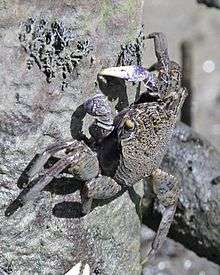Episesarma versicolor
| Violet vinegar crab | |
|---|---|
 | |
| Scientific classification | |
| Kingdom: | Animalia |
| Phylum: | Arthropoda |
| Subphylum: | Crustacea |
| Class: | Malacostraca |
| Order: | Decapoda |
| Infraorder: | Brachyura |
| Family: | Sesarmidae |
| Genus: | Episesarma |
| Species: | E. versicolor |
| Binomial name | |
| Episesarma versicolor (Tweedie, 1940) | |
| Synonyms | |
| |
The violet vinegar crab (Episesarma versicolor) is a swimming crab species in the genus Episesarma.[2] Distributed all over marine and brackish waters of Indo-West Pacific regions. It is harvested by many local fishermen for rich proteinaceous food.
Distribution
A mangrove inhabitant, it is found all over Southeast Asian countries such as Southern China, Hong Kong, Indonesia, Malaysia, Philippines, Singapore, Thailand, northern Australia and South Asian countries like Bangladesh, India and Sri Lanka.[3]
Description
Male grows up to maximum length of 5 cm. Carapace square-shaped and relatively flat. Body color brown to brownish grey in carapace with violet colored outer surface of palm with proximal parts. Fingers are whitish.[4]
Ecology
The species is well distributed in mangrove regions, inhabits burrows at tree bases or sometimes within mounds created by Thalassina lobsters. It is feed primarily on calyx and leaves of water plants, margroves and mangrove associates, usually at night. During high timed, they usually climb as high as 6m up trees.[3]
References
| Wikimedia Commons has media related to Episesarma versicolor. |
- ↑ "Episesarma versicolor (Tweedie, 1940)". World Register of Marine Species (WoRMS). Retrieved 1 November 2016.
- ↑ "Tree climbing crab". Wild Singapore. Retrieved 1 November 2016.
- 1 2 "Occurrence of violet vinegar crab Episesarma versicolor Tweedie, 1940 (Crustacea: Decapoda: Brachyura) in mangroves of Pichavaram and Vellar, Tamil Nadu" (PDF). International Journal of Fisheries and Aquatic Studies. 4 (2): 166–169. 2016.
- ↑ "violet vinegar crab". SeaLifeBase. Retrieved 1 November 2016.